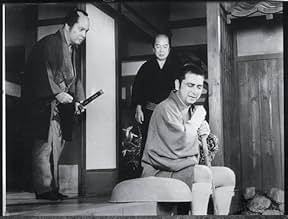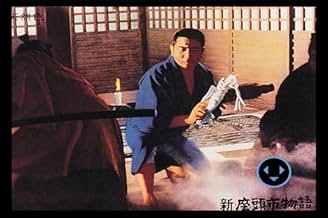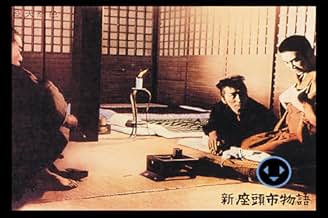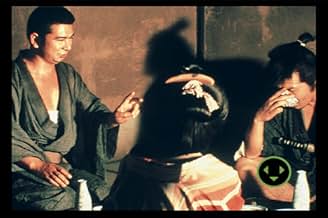IMDb RATING
7.1/10
2.1K
YOUR RATING
Zatoichi promises to deliver a maiden safely home but finds two dangerous gangs have a mysterious interest in the young girl.Zatoichi promises to deliver a maiden safely home but finds two dangerous gangs have a mysterious interest in the young girl.Zatoichi promises to deliver a maiden safely home but finds two dangerous gangs have a mysterious interest in the young girl.
- Director
- Writers
- Stars
- Director
- Writers
- All cast & crew
- Production, box office & more at IMDbPro
Featured reviews
This movie had some great sword-fighting sequences, as well as the usual beautiful (but kinda stupid) young woman falling for the blind gambler. I think that the most compelling sequence, though, is where he rescues the young hostage without drawing a sword. There is something about the transformation of the humble blind man to angry, sarcastic avenger that is compelling. It reminds me of those few Columbo episodes where the detective tips his hand early in the episode, for some reason.
This movie would be an excellent introduction to the series.
This movie would be an excellent introduction to the series.
Fierce fighter, but humble, deferential to a fault, carefully rewards goodness only when he cannot be thanked, protective of innocents --- much like our finest cowboy heroes (Shane, Coop in Noon, Clint).
My wife likes The Shield for the same reasons she likes Hollywood's version of Cosa Nostra: protect the innocent, swiftly and without recourse punish the guilty.
If Michael Corleone ran the justice system, would O.J. be playing golf? Would the beaten, threatened common-law wife be turned away from the police station with "until he actually kills you, the ACLU won't allow us to do anything?"
Just saw the first sequel episode, #2. The print I found appears to be a crude chop job by Janus Films, that marketer having rudely hacked off the correct ending.
My wife likes The Shield for the same reasons she likes Hollywood's version of Cosa Nostra: protect the innocent, swiftly and without recourse punish the guilty.
If Michael Corleone ran the justice system, would O.J. be playing golf? Would the beaten, threatened common-law wife be turned away from the police station with "until he actually kills you, the ACLU won't allow us to do anything?"
Just saw the first sequel episode, #2. The print I found appears to be a crude chop job by Janus Films, that marketer having rudely hacked off the correct ending.
This was the fifth Zatôichi film in just two years. It's been a while since I saw the last one in the series, but they're great fun. Simpler than the previous films, and also far more conventional as an action-adventure, "Zatôichi kenka-tabi" ('Zatôichi on the Road', 1963) stays true to its name, although it could've been called 'The Road To Edo' as well: a road movie of chasing and hiding, of fighting and fleeing to fight again; hide and seek, and pretense. The film greatly picks up in between the fights during the scene at the inn, which is well-made. And it is this sense of, well, it's not predictability because that sounds negative... let's say 'familiarity', that makes it so easy for the viewer to jump right into it – we know where it comes from and where it goes.
It's become a running joke by now to have Zatôichi evade fighting, only to be eluded to a situation where he has to fight. He think he's only on a trip to Edo, while he's taken there to help out at a clan fight. The film is a crescendo of provocation until Zatôichi finally unsheathes his sword. This, of course, makes the films work in the long run: we need a sympathetic character, and having a character who would run around killing people for pleasure doesn't really cut it here. Yet there is a genuinely tragic undersong here: he doesn't search for trouble yet the trouble finds him, and still he is looking for trouble, as he says in the film, by having learnt to fight with the sword.
My favourite moment is the one with the white sunshades on the slope, and Zatôichi running with the children in imitation of the ending of "Det sjunde inseglet" (1957), the other one is the Kurosawan climax.
I do wonder when we're going to have a decent villain, though.
It's become a running joke by now to have Zatôichi evade fighting, only to be eluded to a situation where he has to fight. He think he's only on a trip to Edo, while he's taken there to help out at a clan fight. The film is a crescendo of provocation until Zatôichi finally unsheathes his sword. This, of course, makes the films work in the long run: we need a sympathetic character, and having a character who would run around killing people for pleasure doesn't really cut it here. Yet there is a genuinely tragic undersong here: he doesn't search for trouble yet the trouble finds him, and still he is looking for trouble, as he says in the film, by having learnt to fight with the sword.
My favourite moment is the one with the white sunshades on the slope, and Zatôichi running with the children in imitation of the ending of "Det sjunde inseglet" (1957), the other one is the Kurosawan climax.
I do wonder when we're going to have a decent villain, though.
The following review is an extract from the book "Shintaro Katsu´s Zatoichi: Complete guide to all movies", which is now available on Amazon.
"At the beginning of this film, as a filmic preface, we see how Ichi plays a game of dice (or something similar) with a small group of dishonest opponents. The latter, despite having lost, are not willing to accept defeat, but before they can react, Zatoichi makes them reluctant to even try any hostility against him. With a lightning fast movement of his shikomizue, he cuts a candle that illuminated the room vertically, leaving his opponents astonished, and leaving the room shortly afterwards in the dark (and therefore in relative equality of conditions with others who are able to see). "Darkness is my ally..." says Zatoichi again sheathing his sword in the reed.
The massive duel between the two groups of yakuza recalls by its atmosphere and stylistic characteristics the great Italo-westerns, where a solitary gunman (like Clint Eastwood in Sergio Leone's "Dollar trilogy") must face several enemies at the same time. Leone and other western masters were profusely inspired by the Japanese chambara. The equivalence and parallels between samurais or ronins and solitary cowboys or outlaws are undeniable."
"At the beginning of this film, as a filmic preface, we see how Ichi plays a game of dice (or something similar) with a small group of dishonest opponents. The latter, despite having lost, are not willing to accept defeat, but before they can react, Zatoichi makes them reluctant to even try any hostility against him. With a lightning fast movement of his shikomizue, he cuts a candle that illuminated the room vertically, leaving his opponents astonished, and leaving the room shortly afterwards in the dark (and therefore in relative equality of conditions with others who are able to see). "Darkness is my ally..." says Zatoichi again sheathing his sword in the reed.
The massive duel between the two groups of yakuza recalls by its atmosphere and stylistic characteristics the great Italo-westerns, where a solitary gunman (like Clint Eastwood in Sergio Leone's "Dollar trilogy") must face several enemies at the same time. Leone and other western masters were profusely inspired by the Japanese chambara. The equivalence and parallels between samurais or ronins and solitary cowboys or outlaws are undeniable."
Zatoichi on the Road is the fifth entry in the franchise and the third movie released within one year. In my opinion, this movie is the best of the franchise since the charismatic first film that really established everything one appreciates about the blind samurai who uses his head cleverly and his hands quickly. Zatoichi is being taken to a distant town by a caring employee who wants the blind masseur to meet his boss for reasons that are still unknown to the blind masseur. However, the two men get ambushed by a group of samurai who turn out to be opponents of the boss Zatoichi is supposed to meet. The employee is killed but Zatoichi survives and meets the widow of one of the attackers who is going to become an important antagonist. Zatoichi travels on and meets a dying old man who got attacked by a group of samurai. He helped a young woman who attacked her own master who was trying to rape her. The dying man asks Zatoichi to escort the young woman back to her family in the capital. Zatoichi is unable to refuse a dying man's last wish and protects the young woman on his way towards the capital. However, the widow of the samurai Zatoichi killed and several associates want to kidnap the young woman to harm Zatoichi. Zatoichi ends up being caught in a rivalry between the clan who wanted to hire him for a fight and the clan who attempted to assassinate him. Zatoichi realizes both sides only want to use him for their own purposes and turns against both clans while his main objective remains to bring the young lady back to safety.
There are several elements that make this movie stand out. First of all, the film features less characters with clearer objectives than the confusing predecessor. Secondly, the movie includes two intriguing female characters. The first is the cool vindicative widow who wants to see Zatoichi dead. The second is the desperate and naive girl who is tracked down by her master's samurai and who really needs Zatoichi's help in order to survive. It's refreshing that the screenwriters didn't try to plug a dramatic love story here as Zatoichi treats the young lady like a caring father and even approaches the sinister widow with respect. Thirdly, the movie constantly builds up tension due to several dramatic kidnappings, short but poignant fight sequences and an epic showdown in an abandoned town that positively recalls some samurai classics like Korusawa's Yojimbo.
In the end, Zatoichi on the Road convinces with its quick pace, solid dose of tension and interesting characters, especially the two important female characters which are quite unusual for samurai flicks of that time. Fans of Asian martial arts films should be familiar with this film and collectors and followers of the Zatoichi franchise might see this film as one of the best in the series.
There are several elements that make this movie stand out. First of all, the film features less characters with clearer objectives than the confusing predecessor. Secondly, the movie includes two intriguing female characters. The first is the cool vindicative widow who wants to see Zatoichi dead. The second is the desperate and naive girl who is tracked down by her master's samurai and who really needs Zatoichi's help in order to survive. It's refreshing that the screenwriters didn't try to plug a dramatic love story here as Zatoichi treats the young lady like a caring father and even approaches the sinister widow with respect. Thirdly, the movie constantly builds up tension due to several dramatic kidnappings, short but poignant fight sequences and an epic showdown in an abandoned town that positively recalls some samurai classics like Korusawa's Yojimbo.
In the end, Zatoichi on the Road convinces with its quick pace, solid dose of tension and interesting characters, especially the two important female characters which are quite unusual for samurai flicks of that time. Fans of Asian martial arts films should be familiar with this film and collectors and followers of the Zatoichi franchise might see this film as one of the best in the series.
Did you know
- TriviaZatoichi's katana is a shikomizue. This is a sword which is concealed within a wooden cane, thus the cane itself is both handle and scabbard.
- GoofsThe string attached to the dragonfly is visible as it lands on a bush next to Zatoichi and Mitsu, who are being attacked, and also when it returns after the fight.
- ConnectionsFeatured in Best in Action: 1963 (2019)
- How long is Zatoichi on the Road?Powered by Alexa
Details
- Release date
- Country of origin
- Language
- Also known as
- Zatoichi on the Road
- Production company
- See more company credits at IMDbPro
- Runtime1 hour 25 minutes
- Sound mix
- Aspect ratio
- 2.35 : 1
Contribute to this page
Suggest an edit or add missing content

Top Gap
By what name was La légende de Zatoïchi - Voyage sans repos (1963) officially released in India in English?
Answer


























